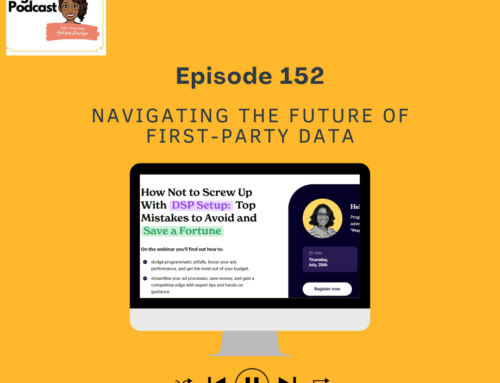Frost Prioleau Discusses Location-Based Targeting
Summary:
This week, we discuss Washington Post’s new contextual beast – Zeus. Is IGTV the new YouTube? Some YouTubers are using IGTV as a testbed. Despite all rumors, Netflix will remain “Ad-Free”. Were you part of the 80 million users of the FaceApp? Not us, we did not fall into the Russian trap. COPPA might be getting another review by the FTC, stay tuned as this law affects programmatic ninjas every day.
Later on, Frost Prioleau joins us in the Sensei’s Corner to discuss research results from a MarketingLand article on Location-based targeting and give us his point of view on GDPR and CPPA.
Frost Prioleau is the Co-Founder and CEO of Simpli.fi. An experienced online advertising executive specializing in targeting, optimization, and technology, Prioleau focuses on corporate strategy, driving Simpli.fi’s growth, and ensuring customer satisfaction.
Considered to be a thought leader in online advertising, Prioleau often speaks on the topic at industry trade shows. In addition, he shares his opinions and insights about retargeting in his monthly column published on Search Engine Land. Prioleau is a graduate of Princeton University, where he earned a Bachelor’s of Science in Engineering Management Systems.
You can find Frost Prioleau on Linkedin | Twitter | Simpli.fi
LISTEN, LIKE, SUBSCRIBE, COMMENT, SHARE!
Shownote:
Article #1: The Washington Post is preparing for post-cookie ad targeting by Jessica Davies
The Zeus platform monitors contextual data such as what article a person is reading or watching, what position they have scrolled to on a page, what URL they have used to arrive there and what they’re clicking on. The publisher will then match that data to its existing audience data pools, which it has accumulated over the last four years, to create assumptions on what that news user’s consumption intent will be. The tool, can be used for display, video, native ads either via direct deals or programmatically, and will be sold at a premium rate given the additional ad-targeting features, although Dicker didn’t disclose an exact price tag.
Media buyers have become more open to paying more for genuinely scarce inventory, which would be the case with the assumed user intent and contextual-targeting capabilities offered by The Post. Many of them are also more actively seeking new ad-targeting options that can drive results for their clients in a GDPR- or CCPA-compliant way.
Article # 2: YouTube stars are using Instagram’s IGTV as a testbed by Tim Peterson
Instagram is allowing big YouTubers to test content via IGTV that could/would not be able to publish on YouTube. Some influencers are appreciating the easy access and process. In the wake of YouTube’s brand safety issues, the platform has become more aggressive in disabling ads on videos that advertisers may not feel comfortable advertising against. And this year the company began to take the production quality of creators’ videos into account when deciding whether to include a YouTube channel in its Google Preferred ad-buying program. As a result, YouTube stars are producing fewer but longer and higher quality videos for YouTube as a way to maintain favor with YouTube’s recommendation algorithm and content review system, as well as to increase their income by inserting more mid-roll ads.
Article #3: Netflix Remains Ad-Free, Keeps ‘Brand Proposition by Wayne Friedman
“We believe we will have a more valuable business in the long term by staying out of competing for ad revenue and instead entirely focusing on competing for viewer satisfaction.” In a letter to the shareholders, the company said: “We, like HBO, are advertising-free.” Globally, Netflix had been estimating a gain of 5 million; it only increased to 2.7 million. Bernstein Research projects Netflix’s cost of revenue to be $12.9 billion this year, $15.8 billion in 2020, and $17.5 billion in 2021.
Article #4: FaceApp goes viral with old-age filter, but spurs privacy concerns with Russian roots by Kelly McCarthy
According to the policy, FaceApp “cannot ensure the security of any information you transmit to FaceApp or guarantee that information on the service may not be accessed, disclosed, altered or destroyed.”
“FaceApp’s privacy page also says they may share user content and your information with businesses that are legally part of the same group of companies,” ABC News chief business correspondent Rebecca Jarvis explained. If you know somebody that is part of the 80 million face app users, please share this information. Let them know to be mindful when it comes to these apps. I know we’ve covered some with Ashley Stevenson and we will continue covering anything that’s data privacy related because it is important.
“It’s a Russian company, so once you grant access,” she added, “you are granting access to all of those companies.” There are currently 80 million FaceApp users.
FaceApp was developed by a small team from St. Petersburg, Russia and has not updated its privacy policy since 2017 when the app previously went viral after criticism for what some considered to be racist filters that lightened users’ skin tones. Be mindful before logging in with your gmail, apple, or facebook account especially to sign up on third-party applications.
Article #5: FTC To Review Children’s Privacy Rules by Wendy Davis
The Federal Trade Commission is gearing up to revisit rules governing online data collection from children younger than 13, the agency said Wednesday in a request for comment from the public. Earlier revisions in 2012, effectively prohibited companies from using behavioral advertising techniques on children younger than 13, without parental consent.
The Children’s Online Privacy and Protection Act, which took effect in 2000, broadly bans Web site operators from knowingly collecting personal information from children under 13 without parental consent. The law empowers the FTC to issue regulations defining key terms, including Web site operators and “personal information.”
Sensei’s Corner Guest: Frost Prioleau, Co-Founder and CEO of Simpli.fi
Interview Article # 1
Greg Sterling in his article on Marketingland says that 89% of marketers using location data sees increase in sales, 86% customer growth and 84% higher customer engagement.
Lawless Research and Factual did a B2B survey of 700 U.S. based mobile marketers which included 536 consumer brands and 164 agencies. When asked the question How do you currently use (or plan to use) location data in your campaigns?
67% answered for targeting, 53% audience engagement, 52% campaign strategy.
But here’s what really stood out only 24% are currently using or plan to use location-based targeting for offline measurement and in-store visitation. Simpli.fi has a pretty advanced mobile location technology where programmatic ninjas like myself can geofences a few locations and report on the conversion zone success. It is such a valuable tool to have in order to tell “cliche” the story some clients want to hear: Xx of people walked through your business after being located at a competitor or in their workplace.
Q: What is your take on this survey result? Only 24% are using location-based data for any offline attribution?
Another question asked was: Which of the following do you use to measure digital advertising effectiveness? 53% answered Website Traffic, 50% purchases or sales, and again only 18% Footfall/in-store visits.
Q: This goes hand in hand with our conversation – What solution do you propose to help move that needle? Being able to really identify what is valuable or redefining success metrics outside of impression count, or brand awareness”?
Sterling points out how Quality and accuracy are the top considerations for these marketers in working with location data partners and 62% of marketers are becoming more sophisticated and increasingly interested into under hood to understand how the data is collected.
Q: Do you think that our technologies are advancing faster than the rest of the industry claims to be? How do you approach this rising trend where agency partners and brands want to really see and understand how data is collected and reported on?
Not included in the article:
How can we explain how important and valuable offline attribution based on location data to those marketers or brands?
GDPR, CPPA, privacy is closer to home than we think – how is this going to affect measurement on the location targeting side specifically for Mobile attribution?
Is Simplifi GDPR and CPPA compliant?
Overall take on privacy compliance rules and regulations from a marketer and consumer POV.
Simpli.fi’s Blog on the interview can be found: PROGRAMMATIC DIGEST PODCAST FEATURES SIMPLI.FI CEO FROST PRIOLEAU AS HE DISCUSSES LOCATION-BASED TARGETING AND WHAT MAKES SIMPLI.FI SO UNIQUE









